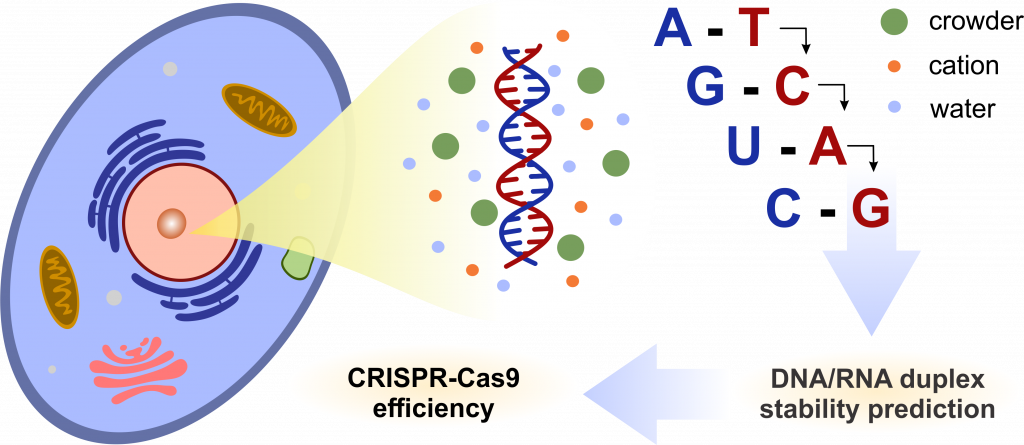PRESS RELEASE: A new tool to predict RNA/DNA duplexes stability in cells
LocationTrieste |
In a study, recently published in the Journal of the American Chemical Society, scientists described a novel tool for prediction of the RNA/DNA hybrid duplexes stability in living cells. To obtain this achievement, which may lead to important therapeutical implications, the research group – that included scientists of the FIBER-Frontier Institute for Biomolecular Engineering Research (Konan University, Japan) and the National Institute of Chemistry (Ljubljana, Slovenia)- worked under the framework of the Central European Research Infrastructure Consortium (CERIC-ERIC).
RNA/DNA hybrid duplexes formation is a crucial step of important biological processes, such as the initiation of replication, transcription elongation, and reverse transcription. Moreover, genetic therapy approaches, such as CRISPR-Cas9 and ASO gene silencing, also rely on effective hybridization of two genetic strands. This process is regulated by forming the so-called R-loops (nucleic acid structures associated with hybrid duplexes and single-stranded DNA), which can inhibit transcription, causing neurological disorders and cancer. The stability of R-loops formation in cells, which in turn depends on the stability of the hybrid duplex, is then crucial to study the pathogenesis of several diseases with a major social impact.
However, if the stability of hybrid duplexes has been fully studied in vitro, these findings can hardly be applied to living cells, characterized by a heterogeneous distribution of biomolecules and cellular organelles that causes molecular crowding, which has a profound impact on the biophysical and biochemical properties (i.e. osmotic pressure, viscosity, dielectric constant, excluded volume) of the intracellular environment. Scientists studied the effects of these conditions on the thermodynamics and structures of the RNA/DNA hybrid duplexes, adding synthetic cosolutes (selected due to their high solubility in water and minimal chemical interaction with the duplex) and analyzing the solution with thermodynamic and Nuclear magnetic resonance (NMR) structural tests.

Researchers found that duplex stability is reduced under crowding conditions, and that this reduction varied significantly depending on the conformation of the hybrid duplex: in fact, NMR studies of the hybrid duplexes under crowded conditions demonstrated the transition from a B- to A-like conformation. “The hydration shell of the A-like hybrid duplex contains more water molecules than that of the B-like duplex – explains Dr Dipanwita Banerjee, researcher at FIBER (University of Konan) and first author of the paper – Because of this significant difference in hydration number, the A-like conformation was destabilized more under crowding conditions than the B-like conformation by decreasing the water activity with the addition of cosolutes”.
“We could then develop a set of parameters that predict the stability of hybrid duplexes with conformational dissimilarities under diverse crowding conditions” further comments Dr Maria Toplishek, researcher at the Slovenian NMR Centre of the National Institute of Chemistry. Interestingly, the parameters they derived allowed to predict the stability of hybrid duplexes, which was consistent with the experimental results for living cells.
“These achievements would not have been possible without the state-of-the-art techniques make available thanks to CERIC-ERIC” explains Prof. Naoki Sugimoto, Director of FIBER. “In fact, this research is a clear example of both excellent science and collaboration across the globe supported by the Consortium” adds Prof. Janez Plavec, Director of the Slovenian NMR Centre.
These results allow to apply the predicted duplex stability to explain the biological processes by understanding the R-loop-mediated regulation of transcription and other crucial processes in a living cell. Moreover, the derived parameters would permit to successfully estimate the efficiency of the CRISPR-Cas9 and ASO techniques, helping to develop novel drug design methods and enhancing therapeutic options for cancer, neurological disorders and other diseases linked to RNA/DNA duplexes stability.
CERIC-ERIC is a research infrastructures consortium founded by the European Commission in 2014. It offers researchers and industry a single point of access to more than 60 techniques and laboratories in eight Central and Eastern European countries for multidisciplinary research at the micro- and nano-level in the fields of advanced materials, biomaterials and nanotechnology.
ORIGINAL ARTICLE:
CONTACTS: CERIC-ERIC Press Office: press@ceric-eric.eu
Marcello Turconi, marcello.turconi@ceric-eric.eu



